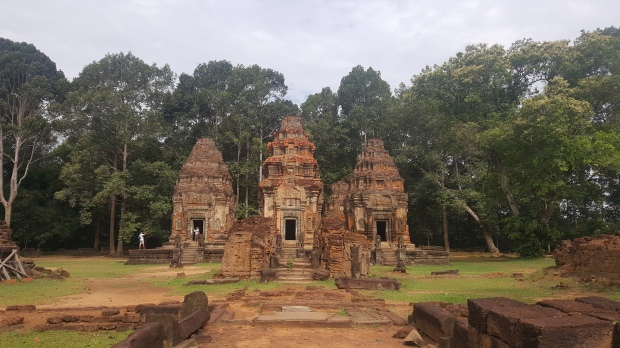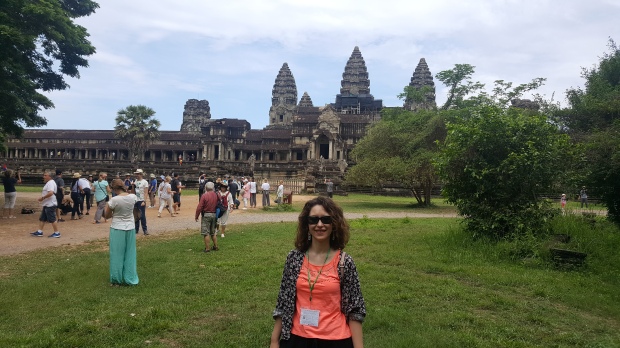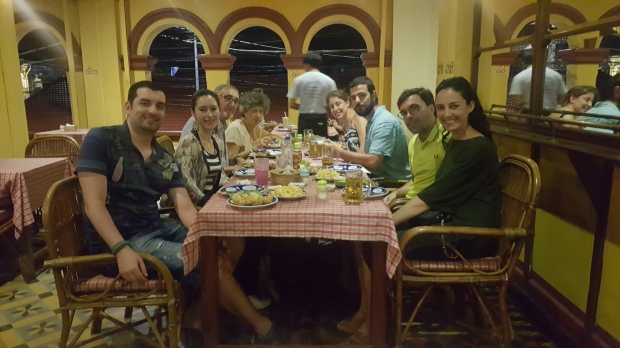Y llega el plato fuerte de mi viaje: los templos de Angkor en Camboya. Y también una novedad en el blog: ¡ahora también podrán leerlo en inglés! A todos aquellos lectores que se incorporan, espero que disfruten mucho con mis andanzas por el mundo.
And now the main attraction of my travel: Angkor in Cambodia. And also a new in this blog: you can read it in english! I hope all the new readers enjoy my travels all over the world (and please, forgive my language mistakes).
El recinto de Angkor está a pocos kilómetros de la ciudad de Siem Reap, donde se encuentran casi todos los hoteles y la famosa Pub Street. Fue declarado Patrimonio de la Humanidad por la UNESCO en 1.992.
En dos días pueden verse los llamados «Circuito Grande» y «Circuito Pequeño». Por ello, contraté desde España una excursión organizada de dos días con guía, uniéndome a un grupo de españoles que venían desde Vietnam. Y fue todo un acierto, ya que descubrí gente encantadora que me hizo sentir parte del grupo desde el primer minuto. Cuando viajas sola y te mezclas en un grupo ya hecho, puede salir bien o no, pero en este caso, me sentí totalmente integrada (Gracias a todos). El tercer día, ya sola, contraté allí un tuk tuk para visitar, el Museo de Angkor y unos templos más lejanos conocidos como «Roulos».
Angkor is very near Siem Reap city, where you can find most of the hotels and the famous Pub Street, full of restaurants and shops. In 1.992, UNESCO inscribed Angkor on the World Heritage List.
In two days you can see «The Big Circle of temples» and «The Little one». I had arranged from Spain a two days trip with a guide and more spanish people. They came from Vietnam on holidays and made me feel part of the group from the first minute. It isn´t easy when you travel alone and suddenly, be a part of a strange group, but I felt very comfortable with them (Thanks for all). The third day I arranged a tuk tuk with a trusted driver to visit alone some temples far away: the Roluos.

Fotografía de Turismo Cambodia.
Hay que obtener una tarjeta para visitar el recinto de 1,3 ó 7 días. Tiene tu foto y la solicitan en todos los templos antes de entrar. Si contratas un tuk tuk, debes saber que los conductores no pueden pasar a explicarte el templo; sólo los guías oficiales pueden pasar contigo dentro; casi todos suelen ofrecerte una botella de agua helada tras cada templo, algo que agradecerás. Y una nota más: a los templos hay que pasar con manga corta al menos…¡nada de tirantes!
You must have an admission pass to visit the Archaeological Park. They are sold in one-day, three-day and seven-day blocks, but you have to use it on consecutive days. It has your photo and it will be checked in every temple. If you paid a tuk tuk, you have to know that the driver will leave and wait you at the entrance but can´t go with you inside the temple; only an official guide can explain inside. Most of drivers and guides offers frozen water when you exit the temple so you don´t need to take drinks with you. And don´t forget to wear long sleeves inside the temples!
La ciudad de Angkor fue contruida en el s.IX por orden del rey Suryavarman II. Es un recinto que alojó diferentes templos y palacios en la época gloriosa del imperio jémer (entre el s. IX y XV). La religión predominante entonces era el hinduismo, que fue sustituido posteriormente por el budismo. El rey Jayavarman VII reconvirtió la ciudad al hinduismo durante un breve periodo de tiempo a finales del s.XIII, destruyendo templos como Bayón, Ta Prohm y Preah Khan, que eran ya budistas. Afortunadamente, la mayoría de los templos están restaurados o en proceso de restauración y son todos visitables.
The Kmer king Suryavarman II stablished the capital in Angkor in 800 AC. Angkor means «city» in Sanscrit. The years after, lots of palaces, buildings and temples were built. The dominant religion was Hinduism. At the end of the 12th century, King Jayavarman VII adopted Budism and a hundred years after, Hinduism was restored for a few years and the new king destroyed most of Budism temples (Bayon, Ta Prohn and Preh Khan). Hopefully, they are now restored.

Se cree que la ciudad fue abandonada por el declive del imperio tras las invasiones siamesas y mongólicas, y por la acuciante necesidad de tener un puerto fluvial para el comercio, del que aquí carecían. Se ha demostrado recientemente el gran sistema hidráulico de la ciudad, que permitía acumular la lluvia de los monzones para producir doble cosecha. Un fallo en este sistema o una gran sequía pudieron ser también causa del abandono. La ciudad fue cubierta por la selva, excepto Angkor Wat, y hasta el s. XIX no fue recuperada.
Angkor is also considered an «hydraulic city» because it had a water network used to support the population and irrigation. It is believed that Angkor was abandoned because of Siam and Mongols invaders, or a water network failure. The jungle covered the buildings till the 19th century, where it was rediscovered.
ANGKOR WAT: Es el templo más grande y conocido. De hecho forma parte de la bandera del país. Fue construido en el s.XII bajo el reinado del rey Suryavarman II. Era Palacio Real y el Templo Principal de la ciudad. Se cree que podían vivir allí unas 20.000 personas. Fue dedicado al dios hindú Visnú, aunque luego cambió al budismo y fue remodelado.
Angkor Wat is the biggest temple and the image in Cambodia´s flag. It was built in 12th century by King Suryavarman II. It was a Royal Palace and Main Temple and it is widely believed that 20.000 people lived here. The temple is dedicated to Visnu, and after, to Buddha. Buddhist monks have always lived here and never left the temple.

Nunca fue abandonado, al contrario del resto de la ciudad, y siempre ha estado habitado por monjes budistas. Consta de 5 torres en forma de flor de loto y 3 recintos rectangulares conectados. Todo está rodeado por un gran lago y se accede mediante pasarelas.
It has a rectangular ground plan with 5 lotus flower- shaped towers and it is sorrounded by a big lake… you can cross it by an artificial brigde.

Si por fuera es espectacular, no pueden imaginarse cómo es por dentro. Tras esperar la fila para subir al piso superior, les esperan decenas de patios repletos de bajorrelieves y esculturas.
When you see the building facade, you can´t imagine the inside. You have to wait the queue and climb the stairs to see many cloisters flanked by statues and bas-reliefs.

Al salir, pensé que ver algo tan espectacular era irrepetible, ¡y qué equivocada estaba! Cada templo es diferente al anterior, y a mí me gustaron más los templos pequeños, quizá porque antes de ir ya has visto mucho Angkor Wat en fotografías y ya esperas su grandiosidad.
After the exit, I thought it has to be difficult to find more espectacular buildings there… hopefully I was wrong! Each temple is different to another, and I loved the little ones, perhaps because they are still unknown.
TA PROHM: sin duda es el templo más cinéfilo. Se le conoce por aparecer en la película «Tomb Raider», protagonizada por Angelina Jolie. Gracias a esta película, que muestra otros templos del recinto, se reactivó el turismo y los camboyanos están muy agradecidos a esta actriz, que adoptó también un niño camboyano al acabar el rodaje de la película.
Ta Prohm is, without a doubt, a film lover temple. It is shown in «Tomb Raider» film, where Angelina Jolie led the main character. Thanks to this film, that shows lots of Angkor temples, turism was relaunched. Local people are also very grateful to Angelina for the adoption of her first child.

Fue construido en época del rey Jayavarman VII a principios del s. XII en honor a su madre. El rey que le sucedió se convirtió al budismo y destruyó bajorrelieves hinduistas para construir otros budistas, algo que verán, se hizo también en otros templos. Estaba decorado por piedras preciosas, perlas y oro que, obviamente, han desaparecido.
It was built in the 12th century by the King Jayavarman VII in honor of his mother. Next King adoppted Budhism and destroyed Hindu bas-reliefs to build other Buddhist. Inside, the temple was full of pearls, gold and gemstones… obviously, they were stolen.

El templo no decepciona; es el único que se ha mantenido tal cual estaban todos, cubierto por ficus. En su conservación colabora un equipo indio, encargado de conservar el templo y la vegetación.
The team of restauration proffesionals decided to keep the temple as it was, wtih all the ficus. India is in charge of the conservation today. When you see this, you can imagine the rest of the temples in the jungle some years ago.
Y debo dejarles aquí, ¡o ésto parecerá un libro en lugar de un blog! Quedan muchos templos y muchas historias que contar… aquí les espero, no sin antes brindar por mis compañeros esos días.
And I must stop here… or this will look like a book instead of a blog! I have lots of stories to tell you so, stay tuned!

Great people saying: Cheers!






Sigues contando cosas interesantes. Enhorabuena y espero en breve seguir leyendo más.
Me gustaMe gusta
Un buen relato de estos maravillosos templos.. Grandes viajes, grandes recuerdos.
Me gustaMe gusta